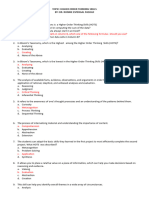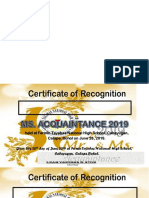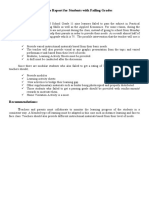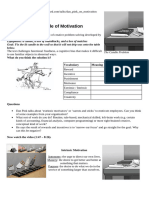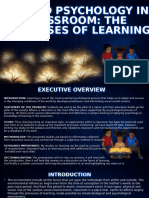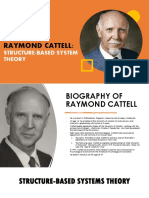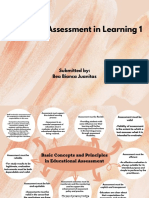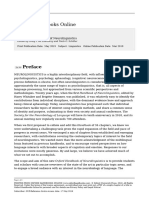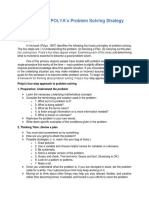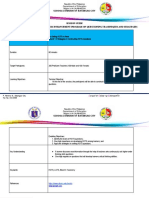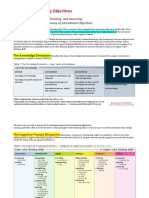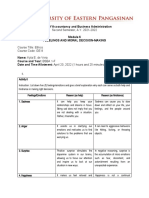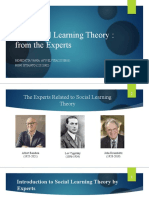Pretest Posttest
Pretest Posttest
Uploaded by
Maureen Mae PerezCopyright:
Available Formats
Pretest Posttest
Pretest Posttest
Uploaded by
Maureen Mae PerezOriginal Title
Copyright
Available Formats
Share this document
Did you find this document useful?
Is this content inappropriate?
Copyright:
Available Formats
Pretest Posttest
Pretest Posttest
Uploaded by
Maureen Mae PerezCopyright:
Available Formats
PRETEST/POSTTEST
School-Based Training on Higher Order Thinking Skills –
Professional Learning Package (HOTS-PLP) in English, Science, and
Mathematics
November 25-27, 2024
1) Which of the following is/are a higher-order thinking skill/s?
i. comparing different views
ii. making informed generalization
iii. listing information previously memorized
iv. recalling ideas or experiences in a sequence
a) i and ii
b) i and iii
c) ii and iii
d) ii and iv
2) How many levels of SOLO are there?
a) 3
b) 4
c) 5
d) 6
3) What does SOLO stand for?
a) Standard of Observed Learning Outcome
b) Standard of Observed Learner’s Outcome
c) Structure of Observed Learning Outcome
d) Structure of Observed Learner’s Outcome
4) What is the SOLO level where conclusions can be held open for logical
alternatives?
a) Unistructural
b) Multistructural
c) Relational
d) Extended abstract
5) What is the SOLO level illustrated in the figure?
a) Unistructural
b) Multistructural
c) Relational
d) Extended abstract
6) The teacher assigns students to work in pairs for short discussion
activities. Which learning approach does the teacher exemplify?
a) inquiry-based
b) metacognitive
c) cooperative and collaborative
d) critical thinking and problem-solving
7) Students are trained in planning how to approach a learning task, using
appropriate skills and strategies to solve a problem, monitoring their
own comprehension of a text, and evaluating their progress toward the
completion of a task. Which learning approach do these activities
characterize?
a) inquiry-based
b) metacognitive
c) cooperative and collaborative
d) critical thinking and problem-solving
8) Which learning approach does the teacher exhibit when he or she
engages learners in different kinds of questions, gets them to develop
different skills, gives them varied assignments, and gets them to work
together?
a) inquiry-based
b) metacognitive
c) cooperative and collaborative
d) critical thinking and problem-solving
9) Analyze the question below and identify its SOLO level.
How would you classify an egg-laying animal covered with
dry, scaly skin and four legs used for crawling?
a) Unistructural
b) Multistructural
c) Relational
d) Extended abstract
10) Analyze the question below and identify its SOLO level.
Enumerate the step-by-step process of making homemade
ice cream.
a) Unistructural
b) Multistructural
c) Relational
d) Extended abstract
11) Which of the following statements is/are best to remember when
writing rationalizations?
I. Keep it concise but complete.
II. Focus on two things – explain why the answer is at the same solo
framework level (or multiple possible levels) with the question
and check on the accuracy of the concept.
III. Ensure the connection among the required competency, stem,
question, and acceptable answer.
IV. Do not accept the answer of the students if it goes
beyond a unistructural or multistructural level question.
a) I only
b) II and III
c) I, II and III
d) I, II, III and IV
12) To which classroom teaching-learning process may a teacher
use SOLO?
a) objective setting/motivation
b) review of previous lesson
c) assignment setting
d) assessment of learning
13) Which of the following statement best describes SOLO as a
framework? Choose one.
a) It connects students’ prior and new learning.
b) It requires students to connect ideas.
c) It supports learning.
d) It encompasses learning.
14) The SOLO model may be adopted by all teachers because its
focus is relevant to all subjects and all learning activities in schools.
Which of the following is NOT TRUE about using the SOLO model
in the teaching and learning process?
a) SOLO motivates students to ponder where they are presently
in terms of their level of understanding, and what they must
do to progress.
b) SOLO has been used as a framework in the development of the
three professional standards in the context of Philippine
education.
c) SOLO offers clear learning pathways that help teachers
focus on content knowledge.
d) SOLO offers assistance in writing only test questions that
can differentiate higher-order and lower-order ideas.
15) Which best explains a prestructural response?
a) It has no significance.
b) It is not clear.
c) It is wrong.
d) It does not connect ideas.
16) Which statement supports the use of SOLO in determining the
level of the students’ performance?
a) SOLO shows student knowledge via his or her responses.
b) Students show evidence of knowledge through observable
outcome.
c) Responses may be labelled using SOLO codes.
d) SOLO shows interplay between what is taught and what is
learned.
17) Which of the following statements is/are best to remember
when writing rationalizations?
I. Keep it concise but complete.
II. Focus on two things – explain why the answer is at the same solo
framework level (or multiple possible levels) with the question and
check on the accuracy of the concept.
III. Ensure the connection among the required competency, stem,
question, and acceptable answer.
IV. Do not accept the answer of the students if it goes beyond a
unistructural or multistructural level question.
a) I only
b) II and III
c) I, II and III
d) I, II, III and IV
18) To which classroom teaching-learning process may a teacher
use SOLO?
a) objective setting/motivation
b) review of previous lesson
c) assignment setting
d) assessment of learning
19) Which of the following statement best describes SOLO as a
framework? Choose one.
a) It connects students’ prior and new learning.
b) It requires students to connect ideas.
c) It supports learning.
d) It assesses learners.
20) The SOLO model may be adopted by all teachers because its
focus is relevant to all subjects and all learning activities in schools.
Which of the following is NOT TRUE about using the SOLO model
in the teaching and learning process?
a) SOLO motivates students to ponder where they are presently
in terms of their level of understanding, and what they must
do to progress.
b) SOLO has been used as a framework in the development of the
three professional standards in the context of Philippine
education.
c) SOLO offers clear learning pathways that help teachers
focus on content knowledge.
d) SOLO helps in writing only test questions that can
differentiate higher-order and lower-order ideas
1. a) i and ii
(Comparing different views and making informed generalizations are higher-order thinking skills.
Listing and recalling are lower-order thinking skills.)
2. c) 5
(SOLO taxonomy has five levels: Prestructural, Unistructural, Multistructural, Relational, and
Extended Abstract.)
3. c) Structure of Observed Learning Outcome
(SOLO stands for “Structure of Observed Learning Outcome.”)
4. d) Extended abstract
(At the extended abstract level, students can generalize and hold conclusions open for logical
alternatives.)
5. For this, I would need to see the figure, but based on typical SOLO structures:
c) Relational or d) Extended abstract are common in examples involving synthesis and evaluation.
6. c) Cooperative and collaborative
(Working in pairs for discussions exemplifies a cooperative and collaborative approach.)
7. b) Metacognitive
(Activities such as planning, monitoring, and evaluating are associated with metacognitive
strategies.)
8. c) Cooperative and collaborative
(The question describes collaborative tasks and teamwork.)
9. c) Relational
(Classifying animals based on specific characteristics involves connecting multiple ideas, typical of
the relational level.)
10. b) Multistructural
(Listing steps in a process is typically a multistructural task as it involves multiple elements but
lacks synthesis.)
11. c) I, II, and III
(Statements I, II, and III are crucial for writing rationalizations. Statement IV is too restrictive.)
12. d) Assessment of learning
(SOLO is often used to assess levels of learning and understanding.)
13. b) It requires students to connect ideas
(SOLO emphasizes the increasing complexity of ideas and connections between them.)
14. d) SOLO helps in writing only test questions that can differentiate higher-order and lower-
order ideas
(This is not true; SOLO also assists in other aspects of teaching beyond just test questions.)
15. a) It has no significance
(A prestructural response indicates little to no understanding of the task.)
16. b) Students show evidence of knowledge through observable outcomes
(SOLO is about measuring the complexity of student responses as an indication of learning.)
17. c) I, II, and III
18. d) Assessment of learning
(SOLO is primarily used for assessing the depth and structure of learning.)
19. b) It requires students to connect ideas
(SOLO is focused on how students connect and integrate ideas.)
20. d) SOLO helps in writing only test questions that can differentiate higher-order and lower-
order ideas (SOLO’s application goes beyond test questions and can inform various aspects of
teaching and learning.)
You might also like
- English 9 Learning Activity Sheet Quarter 4 MELC 1 NAME: - DATE: - GRADE LEVEL: - SECTIONDocument3 pagesEnglish 9 Learning Activity Sheet Quarter 4 MELC 1 NAME: - DATE: - GRADE LEVEL: - SECTIONChristina FactorNo ratings yet
- The Resiliency of The FilipinosDocument3 pagesThe Resiliency of The FilipinosRosally Gagui100% (1)
- Worksheet 4C EnglishDocument3 pagesWorksheet 4C EnglishMARIAN AGRIPANo ratings yet
- S6 - Facing The Forces finALDocument26 pagesS6 - Facing The Forces finALCytzy Suzzane AronalesNo ratings yet
- 2 Grading Performance Task: Accordion BookDocument2 pages2 Grading Performance Task: Accordion BookAstrix BunNo ratings yet
- Science Diagram RubricDocument1 pageScience Diagram RubricRolly HeridaNo ratings yet
- Objective 11 Rpms PPSTDocument15 pagesObjective 11 Rpms PPSTKing Ace FrancoNo ratings yet
- ACR ON Determining Learners Level of NumeracyDocument4 pagesACR ON Determining Learners Level of NumeracyJennifer SayongNo ratings yet
- Speech ChoirDocument1 pageSpeech ChoirCecille D. Inspired100% (4)
- Daily Lesson LogDocument25 pagesDaily Lesson LogAnonymous pHooz5aH6VNo ratings yet
- Grade 8 Teaching Guide For Catch Up Fridays Quarter3Document3 pagesGrade 8 Teaching Guide For Catch Up Fridays Quarter3ruth.mendoza008100% (1)
- Narrative Report PRIMALS PLUSDocument3 pagesNarrative Report PRIMALS PLUSDHEMIE PIODONo ratings yet
- DLP Achievement TestDocument3 pagesDLP Achievement Testariane galenoNo ratings yet
- (DLP Procedure) : I. ObjectivesDocument7 pages(DLP Procedure) : I. ObjectivesJeah mae TauleNo ratings yet
- IPCRF Sub CoverDocument13 pagesIPCRF Sub CoverPrecious Gabrillo GabagatNo ratings yet
- GIYA FOR READING COMPREHENSION Part 3 - FINALDocument71 pagesGIYA FOR READING COMPREHENSION Part 3 - FINALCharline Matas Miro-DueroNo ratings yet
- Regional Memorandum No. 268 s.2018 2Document54 pagesRegional Memorandum No. 268 s.2018 2Leandro Castañeda Inciong100% (1)
- National Reading MonthDocument3 pagesNational Reading MonthVILLA 2 ANACITA LOCIONNo ratings yet
- S6 - Force Field Analysis + Action Planning TemplateDocument1 pageS6 - Force Field Analysis + Action Planning Templatezaldy mendozaNo ratings yet
- Criteria - Futuristic AttireDocument2 pagesCriteria - Futuristic AttireMa. Bernadette Eballe100% (2)
- Least Learned Competencies 2021Document4 pagesLeast Learned Competencies 2021DAISY TABUCOLNo ratings yet
- NLC TemplateDocument3 pagesNLC TemplateRex YuzonNo ratings yet
- DLL Hots DemoDocument4 pagesDLL Hots DemoCatherine Gutierez-De GulaNo ratings yet
- Worksheet 4A EnglishDocument8 pagesWorksheet 4A EnglishMARIAN AGRIPANo ratings yet
- English: Quarter 4 - Module 1Document12 pagesEnglish: Quarter 4 - Module 1krisha padillaNo ratings yet
- Pre Test Post Test HotsDocument3 pagesPre Test Post Test Hotsronnie pasigui100% (3)
- Monthly Report On GAD Integration TemplateDocument2 pagesMonthly Report On GAD Integration TemplateEngelbert TejadaNo ratings yet
- Hpta Meeting Sy 2023-2024Document18 pagesHpta Meeting Sy 2023-2024Kenan M. Sungahid100% (1)
- Grade 5 WAPDocument5 pagesGrade 5 WAPMarco MedurandaNo ratings yet
- Catch Up Friday SchedDocument1 pageCatch Up Friday SchedRECEL PILASPILAS100% (1)
- DLL Using SoloDocument1 pageDLL Using SoloFlorame Algarme Melano100% (4)
- General Artemio Ricarte Senior High School: #35 Bil-Loca, City of BatacDocument1 pageGeneral Artemio Ricarte Senior High School: #35 Bil-Loca, City of BatacJoe Jayson CaletenaNo ratings yet
- PT2 Scrapbook MechanicsDocument1 pagePT2 Scrapbook MechanicsLyca Venancio Bermeo100% (1)
- Answers To LDM Module 1-5Document33 pagesAnswers To LDM Module 1-5Lielet MatutinoNo ratings yet
- School Form 6 (SF 6)Document1 pageSchool Form 6 (SF 6)Geraldo N. QuillaoNo ratings yet
- Worksheet 3Document1 pageWorksheet 3Gerlyn Divinagracia100% (2)
- Cita WorksheetDocument1 pageCita WorksheetMA. CHARMINA CITANo ratings yet
- Grade 10 Accomplishment ReportDocument8 pagesGrade 10 Accomplishment ReportBrylee CadigalNo ratings yet
- Buenavista National High School: General Scholastic AverageDocument2 pagesBuenavista National High School: General Scholastic AverageBernadette Tan RochaNo ratings yet
- MOA For Drop-OutsDocument1 pageMOA For Drop-OutsMaria Ceryll Detuya BalabagNo ratings yet
- Homeroom Guidance Grade 8 Week 4Document2 pagesHomeroom Guidance Grade 8 Week 4Rd David100% (2)
- DLP For Opening of The ClassDocument2 pagesDLP For Opening of The ClassRey Lacdan GlendroNo ratings yet
- Extemporaneous Speaking ScriptDocument1 pageExtemporaneous Speaking ScriptKhera Joy BarredoNo ratings yet
- Weekly Home Learning Plan 7 Week 4Document2 pagesWeekly Home Learning Plan 7 Week 4Neil AbayNo ratings yet
- This Study Resource Was: Bugtong-At-Sagot-Tagalog-Riddles-Answers - HTMLDocument4 pagesThis Study Resource Was: Bugtong-At-Sagot-Tagalog-Riddles-Answers - HTMLJheris MartinNo ratings yet
- Sf9 Shs FrontDocument4 pagesSf9 Shs FrontJemarjo SalandananNo ratings yet
- Accomplishment Report As of Feb 5-9,2024Document6 pagesAccomplishment Report As of Feb 5-9,2024Divine grace nievaNo ratings yet
- Quiz Bee Mechanics and GuidelinesDocument3 pagesQuiz Bee Mechanics and GuidelinesElisha Borromeo100% (1)
- Certificate For Mr. and Ms. Acquaintance 2019Document7 pagesCertificate For Mr. and Ms. Acquaintance 2019archelie omusoraNo ratings yet
- Spa Mediaarts Grade7 q1 Slmodule1Document19 pagesSpa Mediaarts Grade7 q1 Slmodule1Super ManNo ratings yet
- Ms. Lance Concon Fortune Miler Exceed 10: 20 Year(s) Old P50,000Document2 pagesMs. Lance Concon Fortune Miler Exceed 10: 20 Year(s) Old P50,000Ryana ConconNo ratings yet
- Career Guidance Activity Design 23-24Document14 pagesCareer Guidance Activity Design 23-24AIRA LEGASPINo ratings yet
- Narrative Report For Students With Failing GradesDocument1 pageNarrative Report For Students With Failing GradesJefferson Del RosarioNo ratings yet
- S1 - SD With Notes - Resources WalkthroughDocument24 pagesS1 - SD With Notes - Resources Walkthroughniccareston123No ratings yet
- Johncent Roy Tibordo - Worksheet 1Document2 pagesJohncent Roy Tibordo - Worksheet 1johncent roy tibordoNo ratings yet
- Indicator 4 PPST14 FinalDocument21 pagesIndicator 4 PPST14 FinalJoanna Aubrey LagrosaNo ratings yet
- TRF 9 10Document9 pagesTRF 9 10Arthur LegaspinaNo ratings yet
- Sample Teacher Individual Workweek Plan Accomplishment Sy 2020 2021 1Document5 pagesSample Teacher Individual Workweek Plan Accomplishment Sy 2020 2021 1Ian BondocNo ratings yet
- Pretest - Science - Training On Higher Order Thinking 1Document21 pagesPretest - Science - Training On Higher Order Thinking 1Jehsson CachoNo ratings yet
- 2024 MIDTERM CurrDevDocument3 pages2024 MIDTERM CurrDevJoseph Gerson BalanaNo ratings yet
- QuizDocument1 pageQuizMaureen Mae PerezNo ratings yet
- Day 1 Week 3Document9 pagesDay 1 Week 3Maureen Mae PerezNo ratings yet
- CLT Demo Final 1000xDocument61 pagesCLT Demo Final 1000xMaureen Mae PerezNo ratings yet
- Science Practice Test C66 Science Grades 1Document262 pagesScience Practice Test C66 Science Grades 1Maureen Mae PerezNo ratings yet
- Work Application Plan WAPDocument4 pagesWork Application Plan WAPMaureen Mae Perez100% (1)
- Dan Pink Puzzle of MotivationnewDocument4 pagesDan Pink Puzzle of MotivationnewAldana BenitezNo ratings yet
- Learning ProcessesDocument13 pagesLearning ProcessesCHAO BHARGOV LAHONNo ratings yet
- The Wonder Tree Aubrey Demo LPDocument6 pagesThe Wonder Tree Aubrey Demo LPcharm pantojaNo ratings yet
- Topic 5 Raymond CattellDocument25 pagesTopic 5 Raymond CattellGremond PanchaNo ratings yet
- JUANITAS, Bea Bianca - 3.8. AssignmentDocument3 pagesJUANITAS, Bea Bianca - 3.8. AssignmentBea JuanitasNo ratings yet
- The Oxford Handbook of NeurolinguisticsDocument2 pagesThe Oxford Handbook of Neurolinguisticsademlight39No ratings yet
- Elc151 - Reading QP - Set 2Document12 pagesElc151 - Reading QP - Set 2yasmeenNo ratings yet
- Lesson 2.2. POLYA's Problem Solving StrategydocxDocument5 pagesLesson 2.2. POLYA's Problem Solving StrategydocxJessa RinaNo ratings yet
- Values Vs SkillsDocument13 pagesValues Vs SkillsInstantNo ratings yet
- Creyton Vera - Mla Typed Final Essay Period 3rdDocument6 pagesCreyton Vera - Mla Typed Final Essay Period 3rdapi-729083912No ratings yet
- Observation Forms 1Document4 pagesObservation Forms 1Chariss Joy LacayaNo ratings yet
- LESSON 8 TT EnglishDocument2 pagesLESSON 8 TT EnglishNURBAHIYYAH SYAZWANI BINTI ZAINURIN KPM-GuruNo ratings yet
- Q1 W3 L5 DLP Solving Problems On RAExDocument2 pagesQ1 W3 L5 DLP Solving Problems On RAExArela Jane TumulakNo ratings yet
- Session GuideDocument11 pagesSession Guidejoseph birung100% (1)
- Learning To REGULARDocument3 pagesLearning To REGULARJasmin ChavezNo ratings yet
- CSSE 502 Human Computer Interaction (Intro. To AI - Lec. 1 - An Introduction To Artificial Intelligence) Spring 2024Document43 pagesCSSE 502 Human Computer Interaction (Intro. To AI - Lec. 1 - An Introduction To Artificial Intelligence) Spring 2024Ahmed Hamdy WorkNo ratings yet
- Revised Blooms HandoutDocument3 pagesRevised Blooms HandoutBasco LesandraNo ratings yet
- Communication in LeadershipDocument19 pagesCommunication in Leadershipordergrafik.88No ratings yet
- Hbec1203 BiDocument304 pagesHbec1203 BiVictoriaLimNo ratings yet
- Lesson Plan Letter PPDocument7 pagesLesson Plan Letter PPshamma salemNo ratings yet
- Instructional Plan in AP - Grade 7Document6 pagesInstructional Plan in AP - Grade 7Lara Melissa TabamoNo ratings yet
- Unit 2 LacDocument8 pagesUnit 2 LacAthira I PNo ratings yet
- Lesson 1 Knowing OneselfDocument19 pagesLesson 1 Knowing OneselfglyzzjohaneNo ratings yet
- 601 Final Exam QuestionsDocument3 pages601 Final Exam QuestionsBlist ersNo ratings yet
- FunctionalismDocument28 pagesFunctionalismM TNo ratings yet
- MODULE 2 Lesson 4-6Document4 pagesMODULE 2 Lesson 4-6Elenor May Chantal MessakaraengNo ratings yet
- ETHICS - Module 6Document2 pagesETHICS - Module 6Kyla Estrella de VeraNo ratings yet
- UTS - Chapter 3 - Lesson 2Document6 pagesUTS - Chapter 3 - Lesson 2Kahigame TorunskieNo ratings yet
- 123 ListeningDocument16 pages123 ListeningIsaac MabjaiaNo ratings yet
- The Social Learning TheoryDocument12 pagesThe Social Learning TheoryBETHA NUR SALSABILLANo ratings yet

























